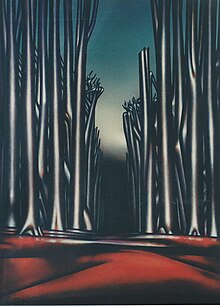Helmut Georg
Helmut Georg (born April 18, 1915 in Lünen / Westphalia; † December 13, 1989 in Bad Honnef ) was a German late Impressionist painter, an artistic war correspondent for the Air Force , and a representative of Expressionism, Art Informel and photorealism.
Life
Georg studied from 1936 to 1939 at the Düsseldorf Art Academy with the painters Paul Bindel (1894–1973) and Franz Kiederich (1873–1950). In 1939 he was called up for military service as an artistic war correspondent in the Air Force. He accompanied missions in the Soviet Union on Lake Ladoga, near Leningrad, in the Caucasus, in Germany and in North Africa. Many of these pictures were on display in 1942 in the “Art of the Front” exhibition by Luftgaukommando VI Münster. Of the works in the late Impressionist style created between 1941 and 1943, 52 have been preserved and are in the Bavarian Army Museum in Ingolstadt .
After the Second World War he settled in Bad Honnef , where his studio was on Mülheimer Straße. There he created symbolic pictures in expressive colors and strong stylization, in which he dealt with destruction, death and deception. He was stylistically influenced in this group of works from 1946 to 1948 by the expressionists Carl Hofer , Georges Rouault and Edvard Munch .
From 1948 onwards, his pictures increasingly dealt with modern life, industrialization and technology: "Gas station", "Railway station" and "Industrial landscape" are the new themes. The objects, which are still clearly recognizable, are elevated to the typical through a strong abstraction . In 1947 his pictures were shown in the exhibition “Young Artists Between Rhine and Weser” in Recklinghausen .
In 1948 Helmut Georg took part in the exhibition “young west”, which was organized for the artist group of the same name in Recklinghausen under the direction of Franz Große-Perdekamp . In 1951, the Duisburg Art Museum, later the Wilhelm Lehmbruck Museum, held the “autumn exhibition “8 oil paintings on the subject of the industrial landscape, including the“ fuel factory. ”In the same year, the Düsseldorf Municipal Art Collection bought one of the industrial paintings from Helmut Georg, which were shown in the“ Iron and Steel ”exhibition in Düsseldorf and then in Duisburg. In May 1952 the University of Edinburgh took over the exhibition under the name “Painters from the Rhine.” It had been prepared by the Bonn artist Martin Frey (1907–1992) and the “Arts Council (Scottish Committee)” sent the presentation through Scotland as a traveling exhibition As one of seven artists from the Rhineland, Georg contributed six oil paintings to the Ernst D'Ham organis ied exhibition “Industry in Contemporary Art” 1953 in the Gustav-Lübcke-Museum in Hamm / Westphalia, 5 works by Georg were shown. At the end of 1953 Helmut Georg withdrew from the public. From the late 1950s onwards, Georg often dealt critically with religious issues: Schematically stylized figures without any relationship to one another have turned away from a crucifix that is viewed from behind and looks out onto an empty road with guard rails. At the beginning of the sixties Georg turned to the non-representational painting of the Informel. From 1969 the language of images and forms changed again: Under the impression of photos from the ruins of Hiroshima, with house walls on which shadows of people can be seen, created by the flash of light from the atomic explosion, Georg paints the picture with meticulous perfection using acrylic technology "Hiroshima" (1969).
This is followed by apocalyptic images of an unleashed technique, such as For example, the picture “Pipelines” from 1978/79 on the shimmering blue tubes snake-like cover the entire red-hot earth up to the deep purple horizon.
"The painter's withdrawn life and his decision not to take part in exhibitions meant that the artist remained almost completely unknown and that his artistic beginnings, which had attracted the interest of state art funding at the end of the 1940s, were completely forgotten."
literature
- Christmut Präger: Helmut Georg. Painting 1935-1985 [on the occasion of the exhibition in the former imperial abbey Aachen-Kornelimünster, November 15, 1998 to January 3, 1999] . Aachen 1998, ISBN 3-00-003600-8 .
Individual evidence
- ↑ Veit Veltzke, art and propaganda in the Wehrmacht, paintings and drawings from the Russian War of 1941-1945, the Prussian Museum NRW in Minden and Wesel, 2005/2006, Kerber Verlag Bielefeld 2005, p 112 fig. O. Z., S. 132 Fig. II.4 and II.5, p. 140 Fig. III.2 and III.3, p. 154 Fig. VI.1 and VI.2, p. 160 Fig. VII.2 and VII.3, P. 250.
- ↑ Veltzke, art and propaganda, p 250; Harald Seiler, The Image of War, ed. from Luftgaukommando VI, Münster i. W. Wehrbetreuung, 1942, color tables on p. 32, 33, 36, 44, 45, 50, 56, 57, 70, 71, 72, 74, 77, 89, 101, 105.
- ^ Karl Günter Werber : Honnefer walks . 2nd revised edition. Verlag Buchhandlung Werber, Bad Honnef 2002, ISBN 3-8311-2913-4 , p. 100 .
- ^ Franz Große-Perdekamp: Art and Weltanschauung, in: Young West 1948, exhibition cat. Engelsburg Recklinghausen, undated; Ferdinand Ullrich: "young west". The history of an artist group, dissertation Bochum 1990, pp. 15-16.
- ↑ Exhibition poster Helmut Georg. Painting 1935–1985. Art from North Rhine-Westphalia, Aachen-Kornelimünster 1998-
- ^ Präger (1998) 41-42
- ↑ Christmut Präger / Wolf Diepenseifen, Helmut Georg. Painting 1935–1985. Monograph on the occasion of the exhibition Art from North Rhine-Westphalia. Funding purchases since 1945. Former Reich Abbey of Aachen-Kornelimünster 1998, pp. 46–47.
- ↑ Fig. S. Präger / Diepenseifen, p. 55.
- ↑ Fig. S. Präger / Diepenseifen, p. 78.
- ↑ from the foreword by the curator Maria Engels in Präger / Diepenseifen, Helmut Georg, p. 6.
| personal data | |
|---|---|
| SURNAME | Georg, Helmut |
| BRIEF DESCRIPTION | German painter |
| DATE OF BIRTH | April 18, 1915 |
| PLACE OF BIRTH | Luenen |
| DATE OF DEATH | December 13, 1989 |
| Place of death | Bad Honnef |


